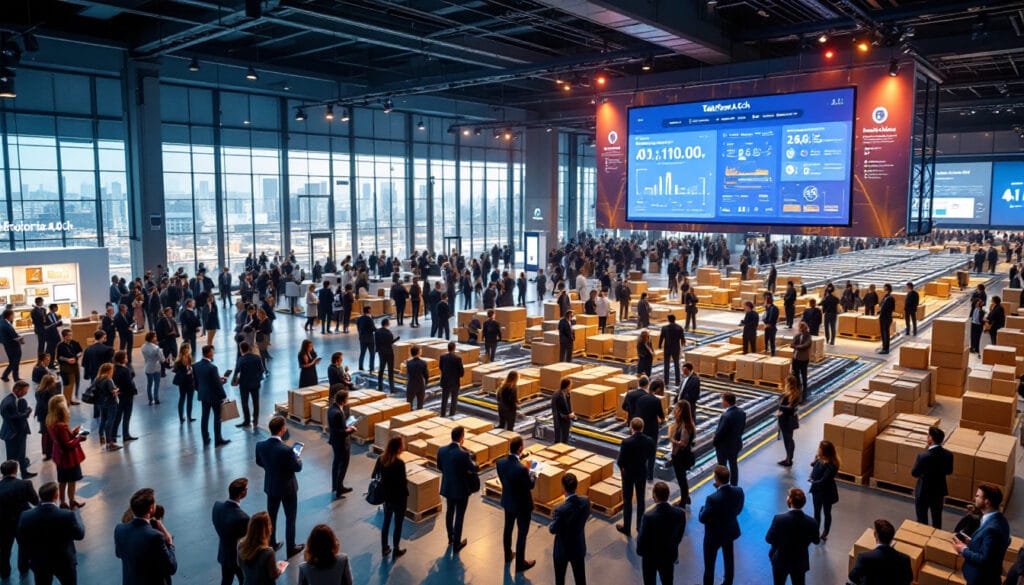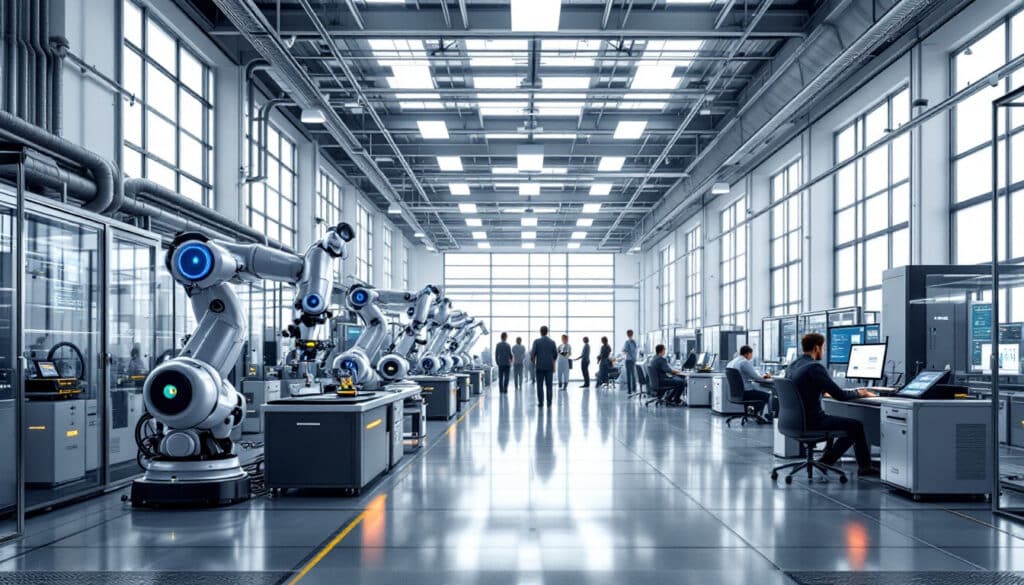The machine vision and collaborative robotics demonstration revealed the full potential of Industry 4.0 during the last NMIS. This innovative system from Beckhoff UK combines magnetic levitation transport with cobots and machine vision. This integration perfectly illustrates the future of smart supply chains.
By leveraging advancements in machine vision and collaborative robotics, this demonstration highlights the optimization of industrial processes. Cobots working in synergy with maglev transport ensure unprecedented efficiency. These innovations enhance the resilience of supply chains in the face of contemporary challenges. Industry 4.0 thus emerges as an era of major technological transformations.
The magnetic levitation demonstration organized by NMIS (New Manufacturing Innovation Show) captivated the attention of professionals in Industry 4.0. This event showcased the advanced integration of machine vision and collaborative robotics, emphasizing their crucial role in transforming modern industrial processes. By utilizing a vision system developed by Beckhoff UK, the demonstration illustrated how magnetic levitation technology can optimize material transport while facilitating harmonious interaction between collaborative robots (cobots) and advanced vision systems.
This initiative demonstrates not only technical innovation but also the benefits in terms of efficiency, accuracy, and flexibility that these technologies bring to the supply chain. By combining maglev with intelligent cobots, companies can envision smoother workflows that are less dependent on traditional mechanical solutions. This technological marriage promises to reduce operational costs while increasing productivity and responsiveness of production systems.
Table des matières
ToggleWhat is machine vision and its role in Industry 4.0?
Machine vision is a branch of technology that enables machines to “see” and interpret their environment through sophisticated sensors and cameras. In the context of Industry 4.0, machine vision plays a central role in the automation and optimization of manufacturing processes. It allows for real-time monitoring, precise defect detection, and intelligent resource management.
During the NMIS demonstration, Beckhoff UK’s vision system was used to monitor magnetic levitation transport, thus ensuring increased precision and efficiency. The ability of machine vision to analyze and adjust operations in real-time helps minimize human errors and maximize the quality of finished products. Furthermore, this technology facilitates integration with other automated systems, creating a highly connected and responsive production environment.
Collaborative robots: a revolution in the supply chain
Collaborative robots, or cobots, are designed to work alongside humans safely and efficiently. Unlike traditional industrial robots, cobots are flexible, easy to reprogram, and capable of adapting to various tasks without requiring major reconfiguration of the production line. This flexibility is essential in Industry 4.0, where customization and quick response to market demands are crucial.
In the NMIS demonstration, cobots were integrated with the machine vision system to orchestrate the transport of materials via magnetic levitation. This collaboration allows for smooth coordination between the movement of items and inspection or assembly operations. By automating these processes, companies can not only increase their productivity but also improve workplace safety by reducing repetitive and physically demanding tasks for human operators.
How magnetic levitation improves industrial efficiency
Magnetic levitation, or maglev, is a technology that uses magnetic fields to lift and propel objects without physical contact. In an industrial environment, this technique offers several significant advantages, including reduced wear on mechanical components, increased movement speed, and decreased maintenance needs.
During the NMIS demonstration, the maglev system was used to transport materials smoothly and silently, thereby eliminating the vibrations and noise often associated with traditional transport systems. This technology also allows for maintaining constant transport conditions, which is essential for manufacturing processes that require high precision. By integrating maglev with machine vision systems and cobots, companies can create faster, cleaner, and more efficient production lines.
The synergies between machine vision and collaborative robotics
The true innovation lies in the synergy between machine vision and collaborative robotics. These technologies, when combined, create intelligent systems capable of making autonomous decisions and optimizing operations in real-time. Machine vision provides the necessary data for cobots to adjust their actions according to the current conditions of the production line.
For example, during the NMIS demonstration, the vision system enabled cobots to detect and adapt to variations in magnetic transport, ensuring perfect synchronization between materials movement and handling operations. This integration not only enhances the accuracy and speed of processes but also reduces errors and waste, contributing to more sustainable and profitable production.
The implications for the future of manufacturing
The integration of machine vision, collaborative robotics, and magnetic levitation opens new perspectives for manufacturing. These technologies allow for a complete rethink of production processes, making factories smarter, more flexible, and more resilient to contemporary challenges. Industry 4.0 is characterized by the use of cyber-physical systems, the Internet of Things (IoT), and advanced data analytics, and the NMIS demonstration perfectly illustrates how these elements can be harmonized to create next-generation production environments.
In the future, we can expect a growing adoption of these technologies, driven by the need to improve operational efficiency, reduce costs, and respond swiftly to market demands. Companies that invest in these innovations will be better positioned to leverage the benefits of intelligent automation, mass customization, and environmental sustainability.
Case study: The impact of maglev on a production line
A leading company in the electronics sector recently integrated a magnetic levitation system combined with machine vision and cobots into its production line. The results were remarkable: a 30% reduction in transport times, a 20% decrease in production defects, and a 25% increase in overall productivity. This transformation not only improved operational efficiency but also allowed the company to position itself as an innovator in the field of smart manufacturing.
While this article does not have a formal conclusion, it is clear that the magnetic levitation demonstration at NMIS has highlighted the immense potential of machine vision and collaborative robotics in Industry 4.0. These technologies, in synergy, offer innovative solutions to optimize production processes, improve product quality, and increase supply chain flexibility. For companies wishing to remain competitive in an ever-changing market, adopting such technologies is not only an opportunity but an unavoidable necessity.





